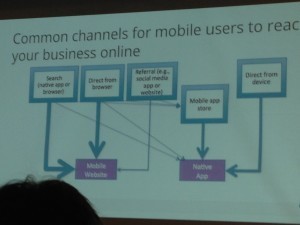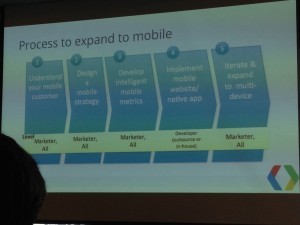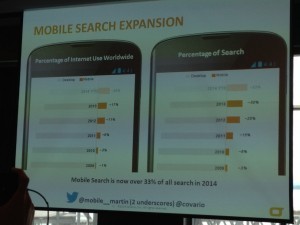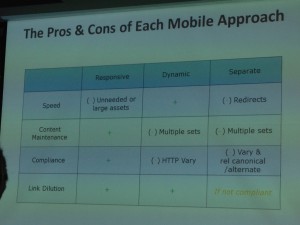SMX Liveblog: What Advanced SEOs Should Be Doing about Mobile SEO
SMX Liveblog: What Advanced SEOs Should Be Doing about Mobile SEO was originally published on BruceClay.com, home of expert search engine optimization tips.
In this session, we’re going to hear from a panel of experts that include:
Cindy Krum, CEO, MobileMoxie (@suzzicks)
Michael Martin, Senior SEO Manager, Covario (@mobile__martin)
Maile Ohye, Senior Developer Programs Engineer, Google Inc. (@maileohye)
Jim Yu, CEO, Brightedge (@jimyu)
Maile Ohye: Search Results on Smart Phones, Mobile Acquisitions Channels, Mobile Opt-ins and More
Websites do appear in SERPs in the mobile environment, but so do apps. Installed apps will show as an autocomplete in the search box. Furthermore, they can take a mobile result for a search and open it within an app, such as an IMDB result on a phone that has that app installed. This is done in order to enhance the user experience. However, in order for this to work it requires deep links within the app and mapping in the sitemap.
Recently Google just launched their Faulty redirect badging for results they’ve found faulty sites in the results. This is a badge you DO NOT want! This tells the user that the site they are about to click on may have issues with it.
Mobile Acquisition Channels

Asking for app downloads isn’t the best thing to do right off the bat – this is better for relationship-ready customers!
Improving the app user experience is much like web SEO:
Good content or service
Enticing search appearance
Optimizing the Mobile Search Pipeline
There are two main bots – both are Googlebot, but one is iPhone specific.
When you develop a mobile website, you want to signal to search engines the relationship you have between the desktop URLs and mobile URLs.
RWD
Dynamic Serving
Google crawls mobile just like they do desktop. They will crawl a desktop site looking for mobile URLs and then re-crawl using the iPhone crawler.
Mobile URL content is clustered with desktop URL content
Indexing signals consolidated
Desktop version is primary source of content
Desktop title is used
Some signals from desktop page are incorporated into mobile rankings. The user experience is so important. Make sure your mobile version is optimized for task completion. As you do mobile SEO, remember that desktop SEO is still important!
Process For Building a Mobile Strategy

Understand your mobile customer
Design a mobile strategy
Develop intelligent mobile metrics
Implement mobile website/native app
Iterate and expand to multi-device
Google does have a checklist for Mobile Website Improvement. They also have a UX testing tool in page speed. They just launched 25 principles of mobile site design, and they have info for help changing mobile site configuration within Google Developers. There is an area for app indexing as well.
When Creating an App
Use deep links
List canonical URLs in sitemap
First-click free experience from search results
Takeaways
Implement technical SEO best practices
Signal desktop/mobile relations
Fix redirect issues
Mobile first doesn’t mean mobile only
Create deep links within native app
Focus on user experience
Fulfill all 5 stages of the process
Cindy Krum: Mobile Page Speed
Krum breaks down mobile ranking signals — Google says explicitly to use bi-directional annotation, implement redirection to a m. subdomain, to avoid broken content and to have quick page speed. Moreover, Google indicates:
no side-to-side scrolling
optimized above the fold rendering
necessary JS inline
necessary CSS inline
No flash
Efficient CSS selectors
Deferred loading of JS
She then elaborates on these important factors …
Understanding Varies: User-agent
This is an explicit signal that tells Google to send the mobile crawler. If you don’t use this, they may still figure it out, but it will take them longer to find, crawl and index. Make it easy on Google.
Broken Content
Google doesn’t want broken content. This means you shouldn’t have things like flash, popups, hover effects, sideways scrolling, tiny font sizes, tiny buttons, device specific content and slow pages. These things will increase your “mobile bounce rate”.
Page Speed
Why is page speed important? It’s important for mobile because if you have a slow page it can hurt the crawler, meaning they won’t get through all the content and they’ll crawl less content upon their visit. It also hurts the user experience. If it’s bad on mobile over WiFi, it’s worse on 3G. People don’t appreciate slow content on mobile. They have higher expectations of mobile content and don’t cut you any slack for slow sites.
 Responsive
ResponsiveWhile in theory, it sounds great for one design to work across all platforms, but the reality isn’t always ideal. It requires additional coding and can cause one version to be bulky and slow it down for one or all devices. The catch 22 is that Google prefers responsive design. However, they also prefer fast page. One isn’t always available with the other.
How do you speed up responsive design? Design for mobile first and remove unnecessary code and minimize your file sizes of all elements on the page. Then, consolidate DNS requests and optimize load order.
Michael Martin: The Mobile Search Result Difference
Mobile Search Expansion goes up every year.
 Mobile search is now over 33% of all search in 2014. With 1 out of every 3 searches done on a mobile device, mobile search is becoming more important than ever.
Mobile search is now over 33% of all search in 2014. With 1 out of every 3 searches done on a mobile device, mobile search is becoming more important than ever.
The mobile search result difference – what is the difference in the search results for:
Generic terms – 58% variance in results from desktop to mobile
Localized terms – 73% difference
The evolution of mobile has gone from .mobi to m. to responsive design to dynamic serving.
To address speed and usability, it’s best to start with Google’s pagespeed insights. This gives you a good starting point.
Next, you want to identify keywords for mobile, and you can use Google’s keyword planner for the mobile users.
From the keywords you want to find out the intent using data available such as the stock of products available nearby, the top number of products and services, reviews, videos and interactions with products, click to call and locations.
Year over year, what are the numbers to prove good responsive design results:
Mobile SEO traffic can increase with responsive design – 81%
Mobile rankings will go up 1
Conversions increase 23%
Looking at average mobile results with non SEO year over year:
Mobile traffic 75%
Mobile rankings increased 1
Conversions 17%
Dynamic/adaptive serving results:
Mobile traffic 167%
Mobile rankings +3
Conversions 82%
Dynamic is beating the average of responsive design or not doing anything at all. Dynamic design is the way to go for the best results.
Advanced Actionable Insights:
Rwd for scale & dynamic for hub pages
Dynamic/adaptive should be used if motile intent is sig. different than desktop
Mobile seo can be applied to dynamice serving
Jim Yu: Common Mobile Search Errors
Mobile is outpacing desktop by 10x, and smartphone share is roughly 23% for search traffic. The anking factors are quite different for mobile vs desktop search. In fact, 62% of keywords have different ranks on the two platforms.
There are different approaches to implementing a mobile site, which were already talked about. Responsive, dynamic and a separate site. Brightedge found minimal performance differences across the types of environments. So they dug deeper and found that most of the errors appeared for those with separate mobile websites. Seventy-two percent of the implements of a separate site were done with errors, while only 30 percent of the dynamic sites had errors.
What happens when you have incorrect implementation? Brightedge found a two position difference meaning a 68% lost smartphone opportunity for traffic.
What really matters to your mobile seo approach?
1. Mis-implementation – smartphone is only becoming more important
2. Ongoing maintenance – you’ve configured everything correctly bu with each website release, the configuration needs to be checked again.
 There are pros and cons to each type of implementation you need to consider when developing your mobile environment.
There are pros and cons to each type of implementation you need to consider when developing your mobile environment.
Summary
• Smartphone share of voice is 23% and growing by 50% year
• Mobile is outpacing desktop 10X
• 62% of keywords have different rank
• Ranking variables are becoming more complex
• There is a slight difference in rank via mobile
• Incorrect implementations can dramatically impact results



